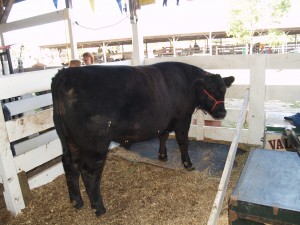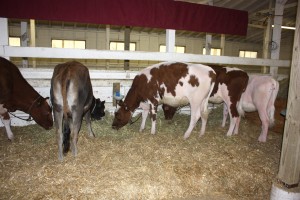If you’re new to the cattle world, keeping bulls, steers, cows and heifers straight is confusing. Even though you once thought that “cow” was a blanket term used for all cattle in all situations, you’ll catch on quickly to the correct terminology.
Bulls
 A bull, also known as a sire, is a mature male bovine that is at least 2 years old used for breeding purposes. Bulls are usually not used for meat.
A bull, also known as a sire, is a mature male bovine that is at least 2 years old used for breeding purposes. Bulls are usually not used for meat.
Bulls are not castrated because they have desired traits that producers want to use for breeding. Typically, a sire will produce more calves in its lifetime than a cow, according to Extension Beef Cattle Breeding Specialist John L. Evans, Ph.D., at Oklahoma State University Extension.
Bulls are usually larger than other cattle. They have large, muscular shoulders, necks and hindquarters. A hump is usually noticeable on its shoulders. When bulls are full grown, they can weigh as much as 2,000 pounds. According to OSU Extension, young bulls can reach half of their mature weights in as little as 14 or 15 months.
Don’t let a bull’s horns trick you; the breed of cattle determines if a bull has horns or not. Museum of Life and Science explains that many dairy breeds will have horns on both male and female cattle.
Steers

A steer won’t be as muscular as a bull. It’s shoulders won’t be as large or muscular. Another way to tell the difference between a bull and a steer is to check if the bovine has testes. If it does, it is a bull; it if doesn’t, it is a steer. Sometimes, it can be difficult to distinguish between steers and heifers. Heifers have a vulva beneath their tails, while steers do not.
Cows

Cows have larger hips and thicker middles. Compared to bulls, they look feminine. Cows should have a slightly angular body shape, lean-looking shoulders and a broad chest, according to University of Arkansas Division of Agriculture.
Heifers

Heifers are similar in appearance to cows, but lack the mature characteristics of cows such as prominent hips and thick middles.
Calves
Both baby male and female cattle are referred to as calves. They’re called weaners once they’re weaned, and then yearlings once they’re a year or two old.
Quickest way to determine gender
Don’t rely on the appearance of horns on cattle to determine if an bovine is a cow or a bull. Instead, look between the animal’s back legs. A side view of the animal will offer you the best view to determine the gender. Cows have udders; bulls have scrotum. Steers will not have testes like bulls. Heifers have teats but no visible udder like cows do.
Also, don’t rely on the color of a cow’s skin to determine if it’s a bull or a cow. A bovine’s breed, not its gender, determines it’s color. For instance, Angus cattle are typically black, Jersey cattle are brown and Holsteins are black and white. For information about cattle breeds, refer to Oklahoma State University’s Department of Animal Sciences page.













I can’t believe you seriously have to explain this to some people.lol
We wanted to provide correct information about cattle, just in case anyone needed clarification!
Katie… please help me with these 3 ???
1… I just read that calf’s mature between 12 to 14 months… means they are ready to be jumped!
It’s not too early? In my youth I did understood that 16 to 18 month was the time.
2… How long after delivered, the cow is healthy enough to be jump again?
3… How many deliveries in average a healthy cow can have in live extent?
Good job.
Answered lots of my questions
Mahalo
Well, I’m glad you did. My grandparents were dairy farmers and I still didn’t remember the difference between a cow and a heifer. So, thank you!
Well Mr. SMART ASS,
I myself was raised in a big city, and never really had the chance to experience being around farm animals. Therefore, I found this article very interesting.
Yes, some people like me need clarification–even though I’m part bovine–yes, since April 2016 I am part cow/bull/steer (one of them) when my cardiologist replaced my leaky aortic valve with a bovine one.
So, yes, even those who are part bovine need explanation! :)
I’m a “City Kid,” whom, until I read Ms. Wood’s article knew that there existed steer, bulls, calfs, and cows. However, other than seeing “horns,” I called all bovines, “Cows.” Lastly, I imagine that I could have a good belly laugh on a few “City” items that I take for granted that “everyone” knew! Peace
You are kidding right?
Most people have Never lived on a farm
If you know so much about it, why are you at this article??
How ignorant YOU are! There are many people especially’Townies’ that wouldn’t/don’t know this. I worked in dairy farming when aged 16 and never had the differences explained.
Thank you Katie for creating this article. It is great as a refresher too for us oldies :-).
People who are brought up in the city don’t know about cattle I had to explain to my granddaughter about it she didn’t know
And I can’t believe there’s someone both so arrogant AND so ignorant as to not understand that literally everything has to be explained, because human beings are not born with knowledge already in our brains. You know, what with the fact that human beings made all these distinctions up in the first place. Not like the cattle talk about it, after all!
You have a typo in the next to last paragraph: heifers DO have teats but no visible udder like cows do. :)
Thank you for pointing that out, Roberta.
Thank you for spelling it out!
Bulls also have teats !!
LOL. If the person is close enough to see the bull’s teats and is still confused, there’s probably no explaining on earth that will help them. Makes me laugh thinking about it. :)
Thank you for clarifying that for people. There are a lot of folks new to the industry. Those of us in farming tend to forget what is was like starting out if you didn’t come from a farm background. There are new folks to the industry all the time.
Thank you for your comment, Kristine. We hope that this information will be useful for those individuals who are new to the ag industry!
Sad to say, but this HAS got to be taught and lernt today by the city and suburban crowd.
As a former HS teacher of decades ago, I am appalled at what passes for “schooling” today. Foolishness.
Most city-slickers don’t have a clue.
When I taught in college and industry, I had a devil of a time getting facts across to students. Their retention and interest were like a colander or sieve. It all just “passed thru.” Very little “stuck.”
Later, I used to give seminars to retirees working in factories and my “gimmick” was to ask the audience what they planned to do when they retired. I asked if they planned on walking in their own back yards. I would then bring out a sprig of an evergreen tree branch and some separate oak leaves and ask the crowd: “Which are deciduous and which are evergreen?”
80% didn’t have a clue…..
Thank you for your comment. We hope that this information will be useful to those outside of the agriculture industry, as well as to those new to farming.
You should correct a couple statements about Bulls. 1. Bulls are not castrated. If so they’d be steers! 2. Certainly the primary purpose for Bulls are breeding, but their meat is in demand for hamburg or extender in others meats to reduce cost.
Hi Joe,
You are correct that bulls aren’t castrated. What is meant by that statement is that bull calves are not castrated because of their desired traits for breeding. I apologize for the misunderstanding.
Katie, I raise Texas Longhorn cattle and after several years of being ask if my Longhorn steers have any calves this year, the answer is yep. Your a brave person to try and explain this and , After you get this all settled try to explain why some breeds , bulls and cows both have horns and some breeds neither have horns. Guess I should say male and females , don’t want to forget the steers and heifers.Wow, just too many choices, not easy raising cattle.
YOU’RE a brave person.
Here in southeast michigan, we have a boyscout ranch called D-A, that raised a herd of longhorns.
I still laugh every time I hear the story of the city kids visiting the farm. One young boy asked the farmer why the cow did not have horns. The farmer was gracious and patient. He said, “There are at least three reasons why this animal might not have horns. Some cattle breeds don’t have horns. Sometimes the horns are removed for safety reasons. Or, the horns may not have grown and developed fully yet. But, the reason this “cow” does not have horns is that it is a horse.”
I don’t care who you are that’s funny right there!!!
Yeppers! Don’t git much better!
Ty for that. Lol
I’m a City slicker and a Latin Percussionist and drum maker who has to buy and mount skins on different types of drums including Bongos and Congas of which there are three official types and names for. And these drums sound different depending on whether it has a cow a bull, a steer or a calf skin on it. People ask for a particular animal because of thickness and sound qualities to mach there playing style etc, but don’t know really what distinguishes one fom the other and I was confused about what the difference was between a Steer and a Bull as well as a heifer apposed to a cow and this article answered all my questions and clarified these things for me. And I appreciate that, now I can inform other drummers who may not know so they can be more informed too. I never can understand how and why educators criticize people for not knowing what they think others should already know. If they knew all these things then they the teachers would have to maybe milk cows or build drums for a living.
Seasoned Citizen, do you know the differences between the three different types of congas drums and or thier respective names? Before you go googling that is.
The joke about the cow that was a horse is funny!
You are awesome! Love your comments and the lesson about drums.
This is a great detailed account of these types of bovine. I am a student who is doing Meat Inspection as one of my courses. Truly, when you are explaining such kind of details sometimes it is amazing on how it seems to be baffling to some students! Especially those who have not been exposed to farm animals. But this does not guarantee us to taunt them. Learning never ends, not all things we expect people to know are known by them. Thank you very much.
Oh Thank you for clarifying for detail. It makes me feel interest how to distinguish cow. Although I am not good at speak English, I understand everything! Thank u
I have a little nephew who came the farm for the very first time. Understand that our family has been in Ag for centuries before we came to the U.S. in the late 1800’s. Wow is the family changing; when my nephew first saw a cow he said, “Look at the big kitty.” So I explained it all to him about goats, horses and cattle. He is very smart and quickly caught on to the terms bull, heifer, cow, though steer took a bit of explaining. “Why, why would they do that,” he said. “Doesn’t it hurt them?” Then he told me that he was a bull and asked me if I was one? I wasn’t ready for that, it blew me out of the water.
When we got back to the house he said, “Mama, did you know you are a cow?”
Kids are great and lots of fun, but never underestimate them, especially on the farm.
Hi Katie,
I’m a new consumer of purchasing meat directly from a farmer. I’m finding that there is a lot to be learned about sustainable farming, grass fed, natural, organic, etc. I know this conversation is different in scope, but the point is unless you are raised on a farm or gain exposure beyond knowing a cow’s sound is “moo” there is a lot to learn. Thank you for posting stuff for people who need 101 education about what may be common knowledge for others. Cow and horse…that means we need to do more to ensure people from various backgrounds are exposed to learning beyond the toils of their neighborhood. This is a job for parents and educators alike. I appreciate what you are doing!
OK, but what’s a “dough-gy”?
Are there Holstein(black and white) bulls? Or only cows are Holsteins? I’m trying to remember if I ever seen one? Maybe I don’t understand something? Educate me!
Holstein is a dairy breed. The color doesn’t determine the sex. Which means you can have a Holstein bull (male), heifer (young female), cow (an older female, usually over 1 1/2 yrs old or older), steer (a male that has been castrated = male parts removed or banded).
Please explain ,”BANDED”. Sounds uncomfortable.
thanks for the reply, so then there can be bulls, cows, steers and heifers for any breed? So I would guess there are Black Angus cows? I live in Lancaster County, PA and I should know this stuff, but most cows here are Holsteins with a few Guernsey here and there. Anyway, thanks for educating me!
Yep! Dairy or beef breeds, it doesn’t matter. Thanks for being willing to ask! I know how you feel about being around one type of farm. I grew up where there were all dairy farmers in a rural area. We raised a few beef cattle and I had horses. There wasn’t any remarks about the cattle, but I was always criticized for having my horses. I heard ‘What are you doing with those hay burners?’, more than once! Didn’t make you feel like you could ask your neighbors anything.
ok, I’ll be on the lookout for Black Angus cows. So horses are hay burners? Never heard that! I live in Amish country, so I see a lot of horses and mules. Most people don’t know exactly what a mule is. That’s why I wasn’t sure if some types of steers are sorta like mules. Anyway, thanks for your info.
Can you clarify this for me? I once worked for Swift & Company and, at that time (1966-69) most beef was from steers (males). I don’t remember selling any cows (females) to restaurants or big supermarkets. We may have sold Heifers, but I don’t remember for sure. Would USDA grade Heifers or Cows? Or just Steers?
Thank you.
Yes. USDA grades heifers and steers but, they will probably have different considerations for carcass quality. Also, the company that is buying the meat may pay differently for a light weight carcass, or a dense carcass from an old animal. Other than that, there really isn’t any way to know which carcass came from a heifer, cow, steer, or bull. (Although, it may be on the carcass tag for point of purchase information.) Some companies purchase by hanging weight and will deduct if the carcass is not optimal quality, while other companies will buy live and pay so much per head or live weight. When live, you can expect most companies to pay a little less per head for heifers vs. steers. A LOT less for old cows and bulls. Hope that helped answer your question!
This is really helpful especially to we Africans that only know Cow and Cattle. I have learnt something new today.Thank you.
Henry Garcia, You have every right to be confused about how old a heifer should be before she can be bred, or jumped. Old wisdom was to wait until they were 16-18 months. They are more mature physically and mentally to carry, and have, a calf. Then big business came along and it’s all about how soon you can get a calf on the ground so you could either get that calf raised for beef or get milk into the coolers sooner.
Wisdom is the key here. By waiting until they are 16-18 months, the heifers will be better framed and tend to have less complications during calving. They also can have a better ‘mothering instinct’ and are less likely to reject the calf at birth. In other words, an easier calving can be the difference between her wanting to have nothing to do with what just happened or being a happy momma!
Cows can be re bred 60-90 days after calving. However, they need to be in good body condition and not thin.
When trying to figure out how many calves you can get during the lifetime of the cow, it’s like counting your chickens before they hatch. Cows can produce for 7-10+yrs, if you have a stress-free and healthy environment. So, you can say 4-6 calves, maybe more. However, a high pressure dairy cow may not make it past 6 before her production declines and she will be sent out for slaughter. Her situation means maybe 3-4 calves. Keep in mind that a heifer or cow can have complications and not be able to be re bred. Or, worse yet, they die during calving. That’s called ‘farming’.
Seems it’s a lot like humans. You’re very fertile in your younger years but as soon as you reach 30+ and can’t have children you’re more or less put out to pasture. Sort of. I liked this article and I googled it to find out. I was raised around cattle and I never knew the difference. I still don’t feel stupid. Thank you for your post!!!!
I have a question. If a cow is never bred, is she a heifer her whole life? I have had cows off and on for 25 years and always bred them. Now I may keep a heifer or two as pets. I am too old to milk them but I really miss having them around and have plenty of space, hay and shelter. They’ll have a good life. I think of heifers as immature female bovines, but the definition of heifer relates not to age but only breeding status. What do you think?
Thank you Katie for the explanation. I arrived to your website looking to know what happens to the male calves and your article not only answered that but more…I feel so much more knowledgeable than most of my other friends & family.
It may be obvious info for someone who is in or associated with the cattle business but for me this info was Brittanica!!!
Thanks for explaining that the bulls aren’t castrated because they have the traits that are desirable for breeding. My husband and I have some land; we’ve discussed the idea of buying and breeding cows because we’ve always liked the idea of owning farm animals. I’m glad I read your article because I guess I never really new the difference between a bull and a steer before.
Thank you lol I just asked my husband about the difference between a bull and steer was . I knew steers we’re castrated but did not know about bulls. Always wondered. Did not know there was a difference between a cow and s heifer. I thought they were the same thing. I was not raised in the city or county.i was a township kid. Not enough land to have cows and found the article very informative.
Thank you! My kiddos just asked me if there are boy cows, and I knew they had different names, but I wanted to be sure to share the correct info. This article is perfect for parents who want to give the correct answers to their curious kids. :)
I found it interesting that you said that bulls can weigh up to 2,000 pounds when they are full grown. My brother told me that he was going to check if owning a farm would be a good idea. Thank you for helping me learn more about bull types and bios.
I always thought that steers were beef-cattle castrated bulls, and that oxen were castrated dairy bulls. And that although dairy bulls were fierce and dangerous, oxen were more placid than steers ]( castrated beef bulls).
We should actually use bovine instead of cow when generally speaking of these mammals since this term covers them all, whereas cows are specifically matured females. Or use ox since it narrows it down to domestic bovines.
So a heifer can become a cow but never the reverse. A steer used to be a bull but never a heifer or cow. All bovine are just fine.
It’s interesting to learn that a bull is 2 years old and is bigger than other cattle. My brother is wanting to get a new bull to breed with some of his cattle now that he has had some experience. He should look for ones that are healthy and of the same breed.
Reading this article has shed some light for me. I was really confused and thought that all cows were cows. I know that comment still makes me sound confused.
Why are the Steers castrated?
What would be different about them growing up if they weren’t castrated?
At what age are they castrated?
If the farm is into breeding, wouldn’t it make sense to have as many bulls running around instead of Steers so plenty of cows and Heifers are impregnated, as to more the merrier?
If you never breed a heifer does she ever become a cow? I was told once a heifer reaches a certain age she is a cow even though she has never had a calf due to her age. I can not find any thing on this to determine if it is true. Any one else go by this rule? If so what age is she considered a cow?
Actually we are artificially inseminating our cows from the past 5 yrs. But they start getting affected with Diarrhea. This continuous up to a week after inseminating. Is it because of a virus or bacteria?Can you please give a clarification regarding this?
Thank you for this explanation! I’m reading a book called Defending Beef and my grandparents were dairy farmers but I never learned *any* of these distinctions. I’m still hung up on this one sentence: “Typically, a sire will produce more calves in its lifetime than a cow, according to Extension Beef Cattle Breeding Specialist John L. Evans, Ph.D., at Oklahoma State University Extension.” How does this make a lick of sense if a sire is just a bull impregnating cows and heifers? What does this quote even mean?? I need to know!
I think the quote simply means an individual bull will have more offspring than an individual cow, which sort of makes sense because the role of the bull is less taxing than the cow’s. And a bull could produce offspring with multiple cows during a calving season.
I helped do cattle when I was young.. been years since than. And I really enjoyed reading. I just bought a 40 acer ranch, and find this article to be great. So thank you
Thank you for explanation. Was watching an old western “ Wells Fargo with Dale Robertson” where they were driving “steers” but had a young man with them that was familiar with “cows”. Of course the joke was “don’t try to milk the steers”. I looked up steers to clarify my mind and your article was great info. Thanks to you ( and the internet) and others like you that can keep folks like me educated about various subjects as they come up. This is trivia worth remembering even for a suburban person like me.
I rode bulls my whole life. I started as a young kid riding steers and heifers, moved up to Jr bulls and then highschool/college we rode bulls often times the same bulls the professionals rode and then I moved up into the pro ranks and my family raises and takes bulls to pro events all over the country and it always amazes me how many people still ask weather a certain bull is a male or female but I understand some people just have much different back grounds and may not know these things. Thanks for explaining your article was a good read.